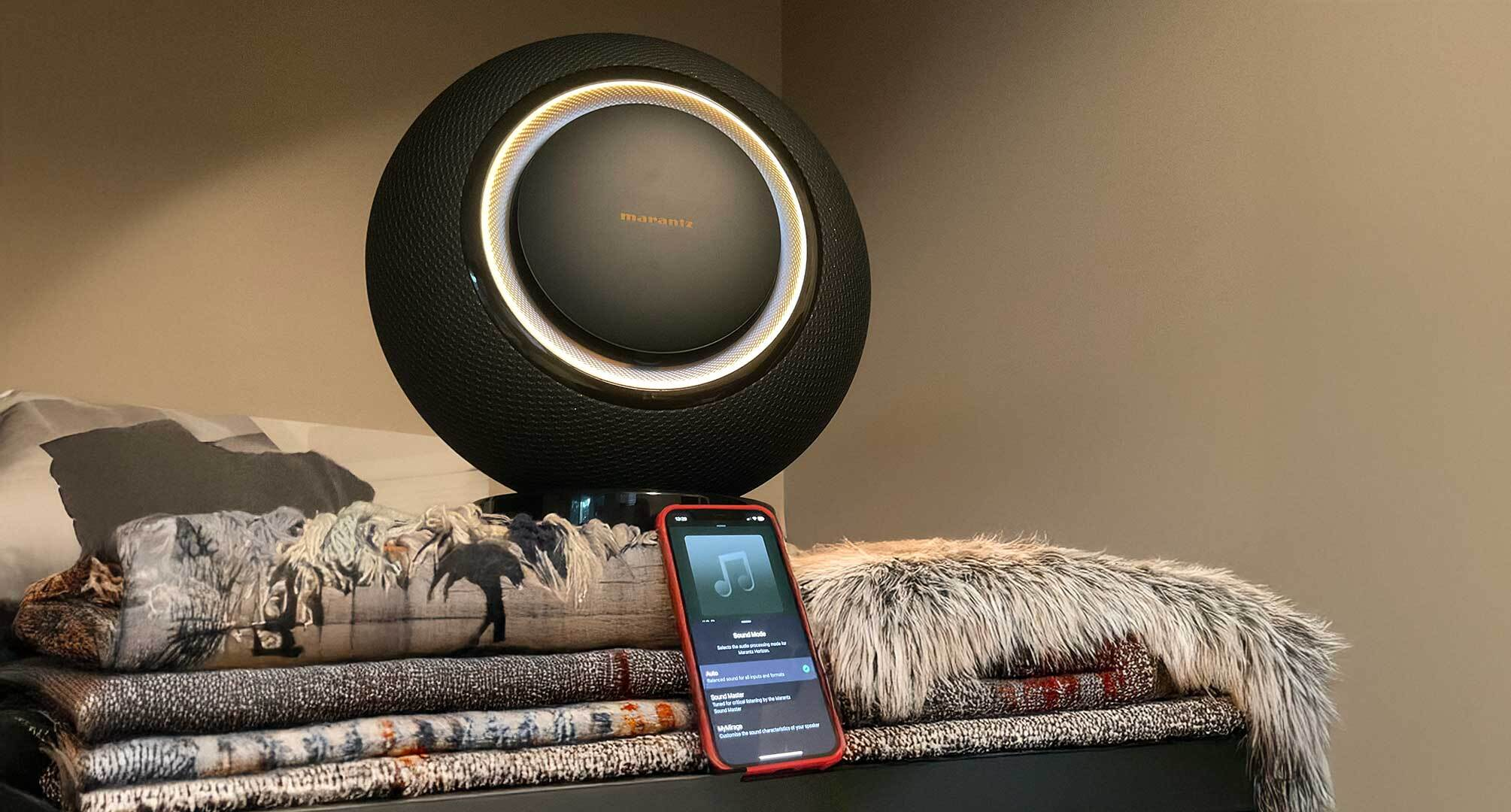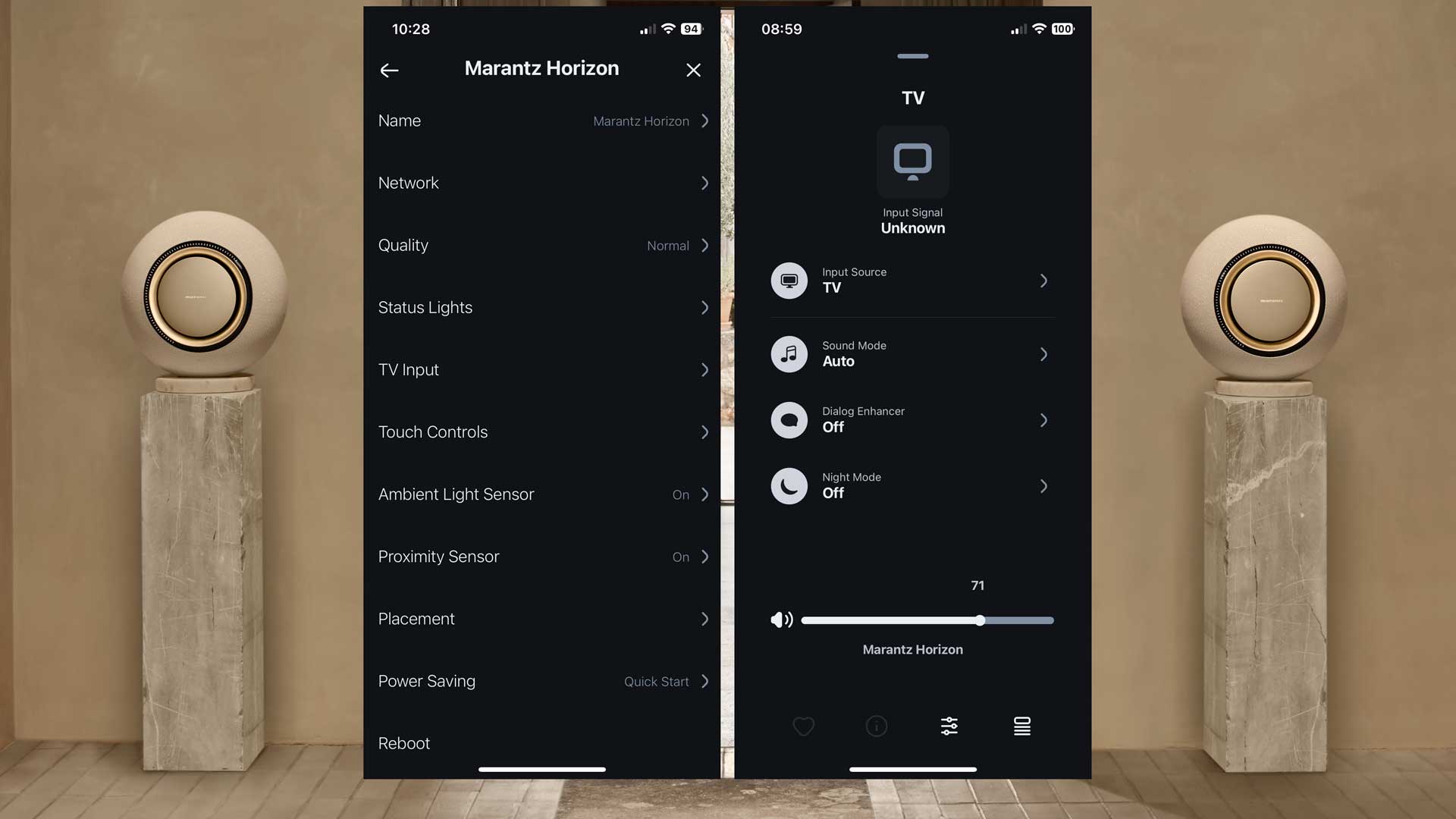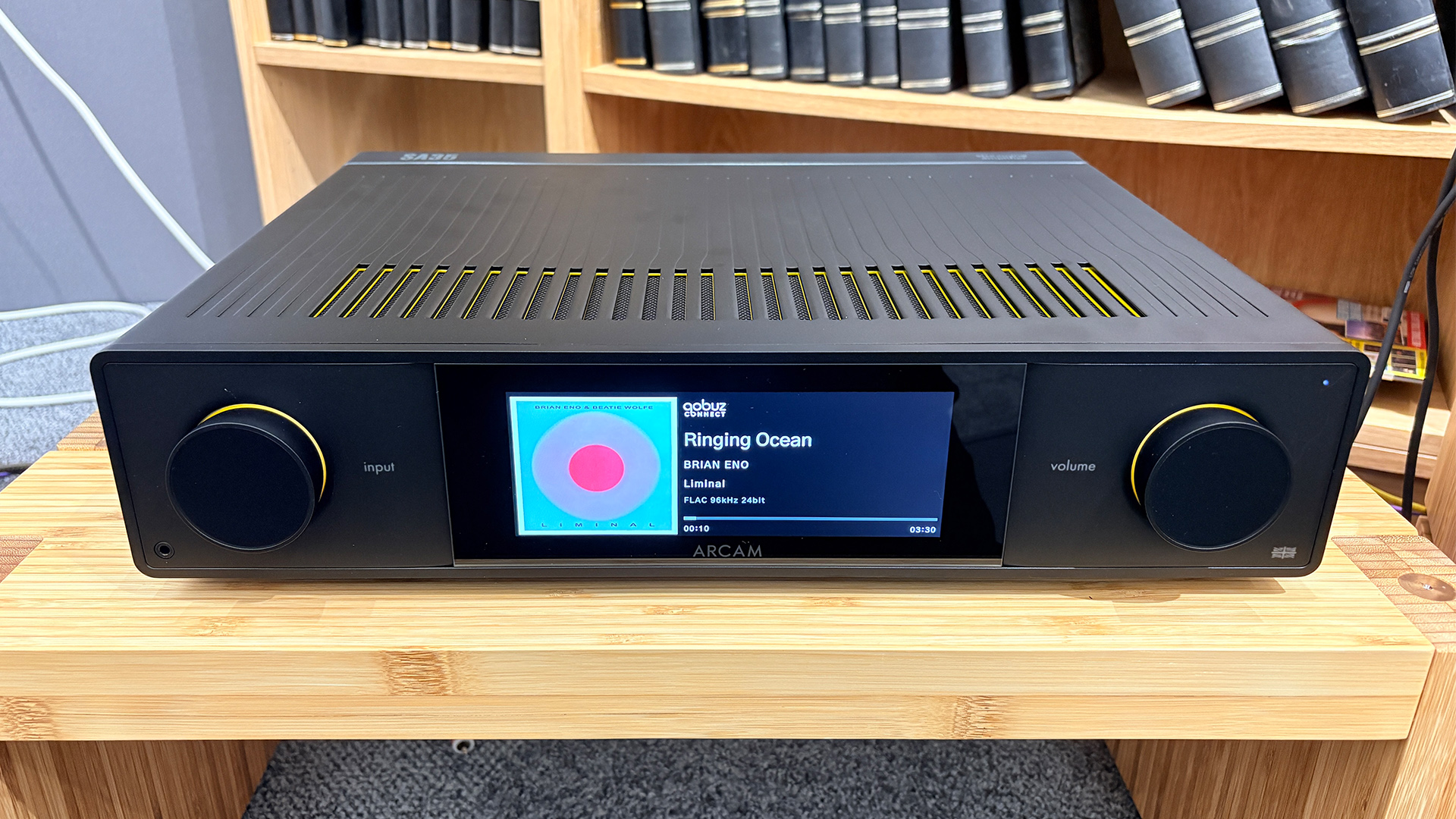Sound+Image Verdict
Well-cast for its chosen 'luxury' role, the Horizon really does look the part, and we can reassure anyone shopping for a wireless speaker at this price that the streaming speaker also comes with a strong dose of the company’s formerly inherent focus on sound quality.
Pros
- +
+ Visual and sonic class
- +
Easy streaming
- +
Useful inputs
Cons
- -
No remote control provided
- -
Poke-don’t-drag AuraControl
- -
AuraControl delay from standby
- -
Price, for some!
Why you can trust What Hi-Fi?
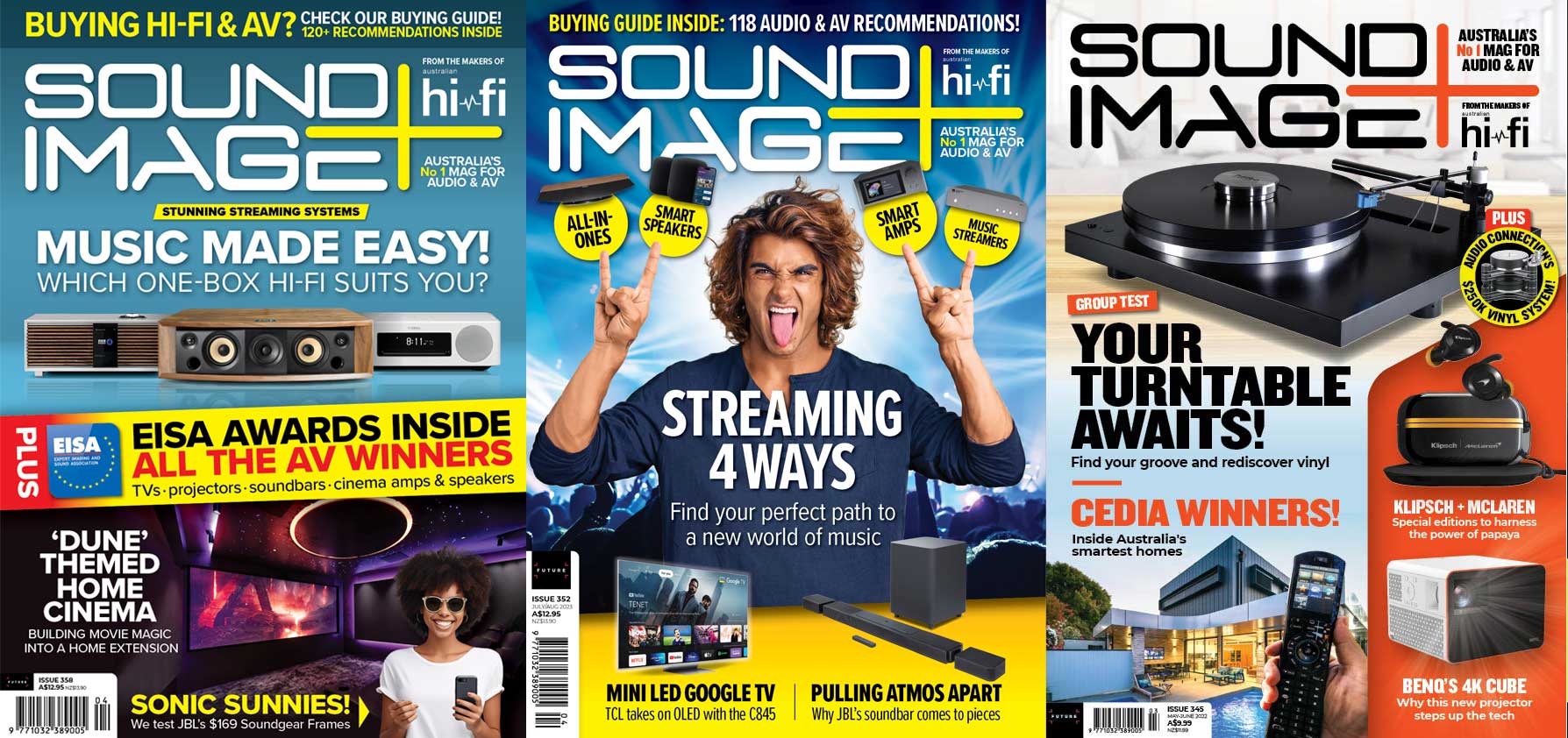
This review originally appeared in Sound+Image magazine, Australian sister publication to What Hi-Fi?. Click here for more information on Sound+Image, including digital editions and details on how you can subscribe.
The high-end and the luxury heights of hi-fi are currently proving the most successful of sectors for those companies that dare to venture into such lofty realms. But one of the truisms of the luxury market is that you’ve gotta look good, as well as sound good. Many moons ago we recall interviewing Antony Michaelson, then owner of Musical Fidelity, who told us that his company’s high-end amps might be built significantly more cheaply, but then nobody would buy them, because they really have to look like they’re worth it, as well as sounding like it.
In this regard, we recently reviewed Meridian’s Ellipse wireless speaker at £1900 / $3000 / AU$4999; it sounded great, performing as we might expect a speaker at such a price to perform. But its design was so surprisingly minimalist and plain that it looked, well, perhaps smart enough, but not really your five grand’s worth.
Compare that with the Marantz Horizon here, a wireless speaker that we have to say really does go a long way towards looking its price. And feeling it too: it weighs 15kg in the box, and 12.5kg out of it, much of this contributed by a large base made of marble – yes marble! (see below). That circular corona of black’n’gold seems to float above the base, even as it glows softly from across the room. It’s very effective, genuinely stylish.
And in just one example of Marantz’s emphasis on luxury presentation, that marble is the real deal, sourced from either Italy or Spain depending on which of the three available Horizon finishes you choose: the ‘Moon Ray’ Horizon comes with Italian Carrara marble, the ‘Marantz Champagne’ model pictured below gets Beige Serpeggianto marble, while the ‘Midnight Sky’ (which we had for review) has dark but delicately inverse white-veined Nero Marquina marble from Spain. Each base will be unique in its natural marbling, while the material is more than mere decoration; its weight also keeps the tall circle safely anchored – you’d have to tilt it well past a full 45-degrees to have the Horizon tip over.
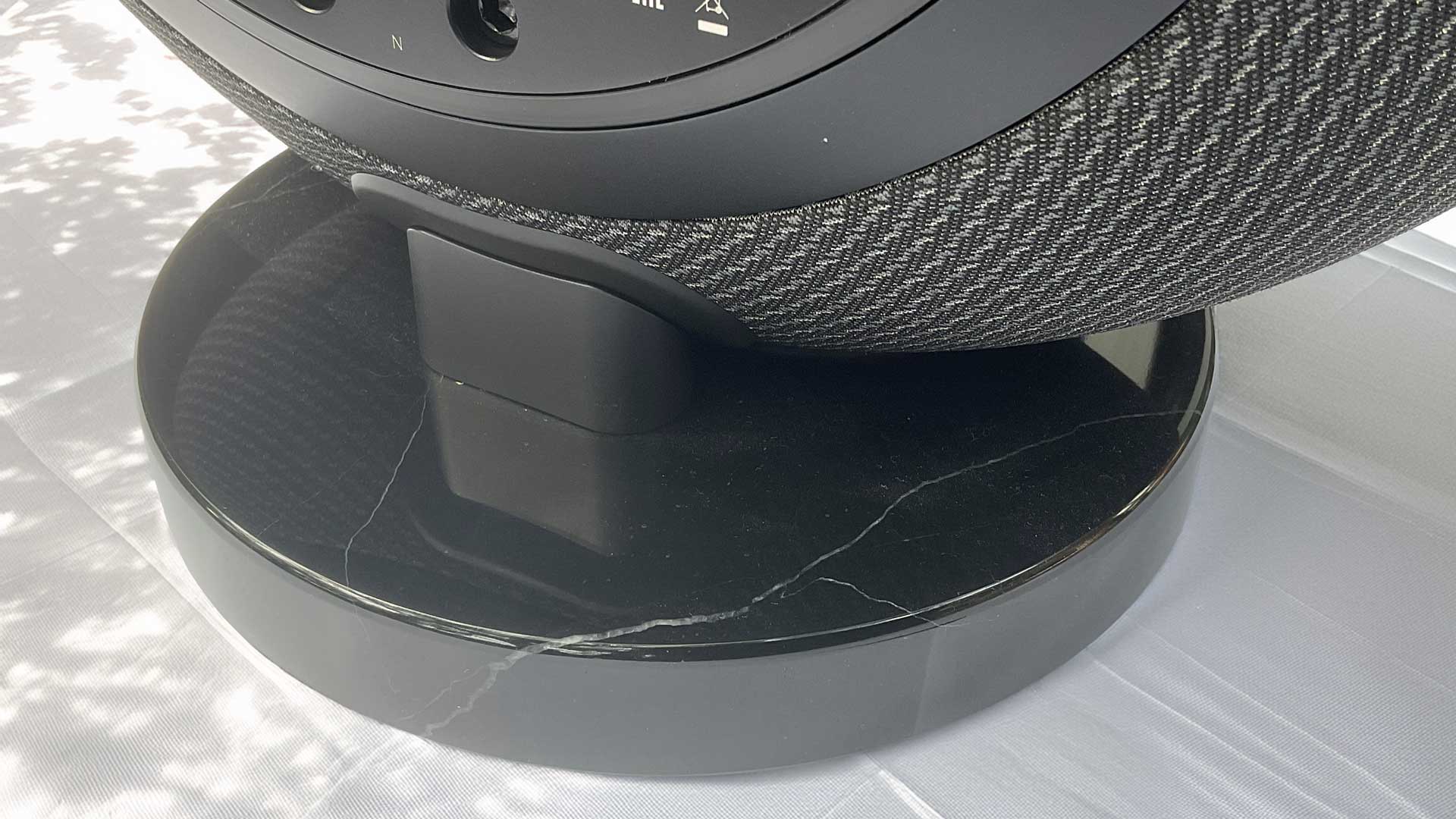
There’s also an optional arty tripod-style stand available (pictured in a lifestyle image below), attaching under the marble, though adding an extra £649 / $700 / A$1500 to the bill.
While the Horizon seems a sizeable feast, there is also a ‘Grand’ Horizon – Grand in having even more (or at least larger) bling than our common Horizon, perhaps also considered Grand in the Yorkshire sense (“Ee, that’s right grand, lad”), and certainly at its even higher price asking several Grand more of your hard-earned to take home – although given the Grand’s boxed weight of around 25kg, we might recommend you get the thing delivered. The Grand Horizon is just too heavy to go on the tripod stand for the smaller model.
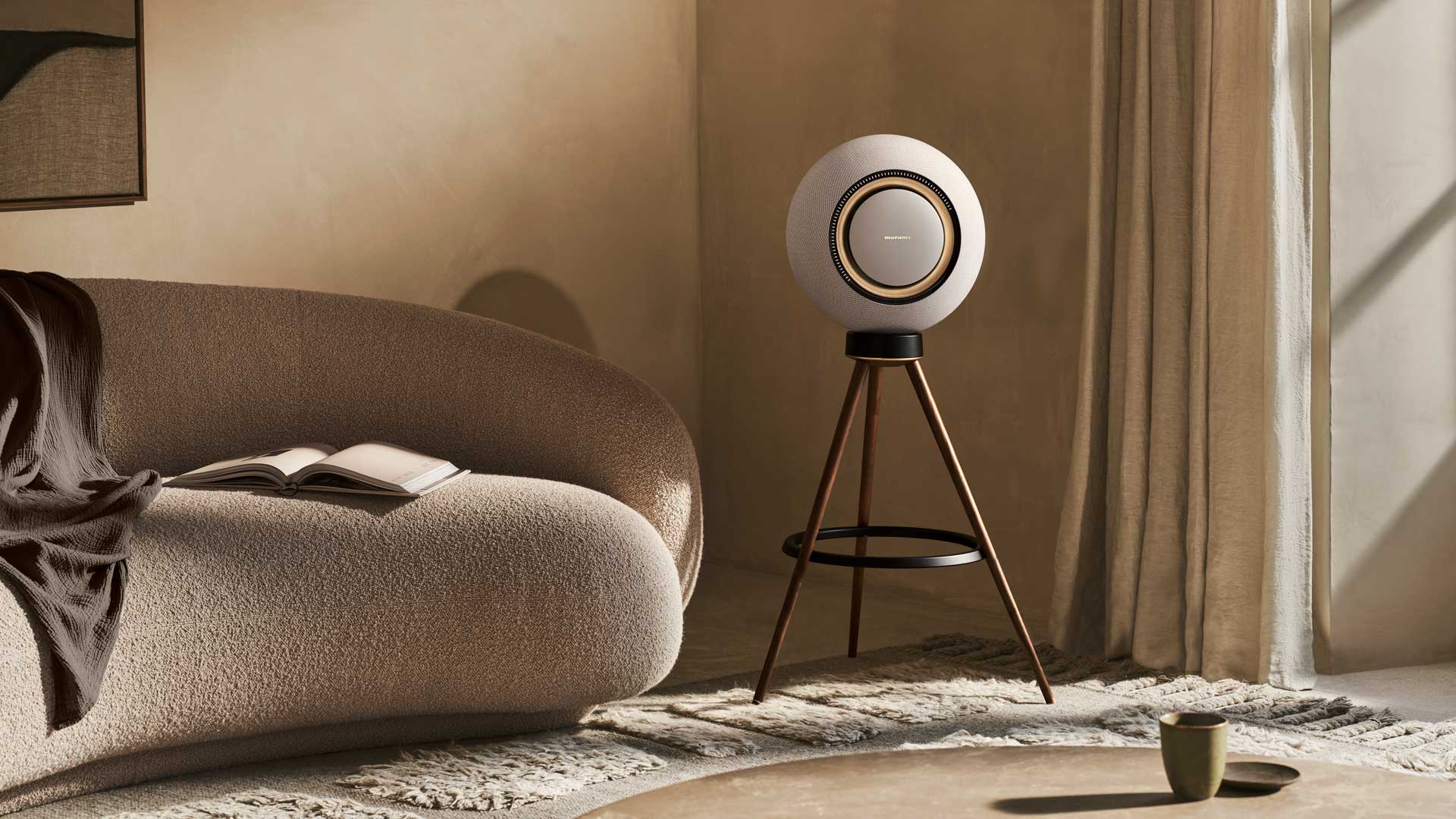
Ring of gold
While the Grand is bigger as well as heavier, the standard Horizon is hardly dinky. Yet it managed to avoid being intrusive visually, particularly our ‘Midnight Sky’ review unit, with its outer black silhouette circle of 36cm diameter receding into the shadows while its illumination hovered above the top shelf of our equipment rack on that base of black marble. Its outer ring is wrapped in a cloth covering of “360° Seamless Ecofiber”, tucking behind the central circle.
The latest hi-fi, home cinema and tech news, reviews, buying advice and deals, direct to your inbox.
Followers of the brand will have noted the ‘interference pattern’ motif introduced by Marantz on its recent amp and receiver releases; it appears here too, and highly effectively shines as a subtle pattern etched on the white curved ring which recedes behind the branded circular front plate. This plate covers the big central front driver, leaving about a centimetre of space around the edges for the driver’s sound to escape. A ring of light on the back of this front plate illuminates the soft circle with its interference pattern, while outside that is another ring, black most of the time but illuminating with up to 100 LED segments which form a touch-sensitive volume-control ring; this detail is lovely, with each volume gradation marked not by a line or a dot but by a tiny elongated rhombus.
This volume ring illuminates when you approach the Horizon (kinda, see below), inviting you to interact and change the volume using this illuminated ring. Which is nice, though we’d have appreciated a remote control as well. Not getting one is a glaring omission at this price, leaving you either to fire up your phone and proceed to the HEOS app each time you want to change volume, or to walk across the room and do the finger poking thing (see below). Where’s the luxury there?
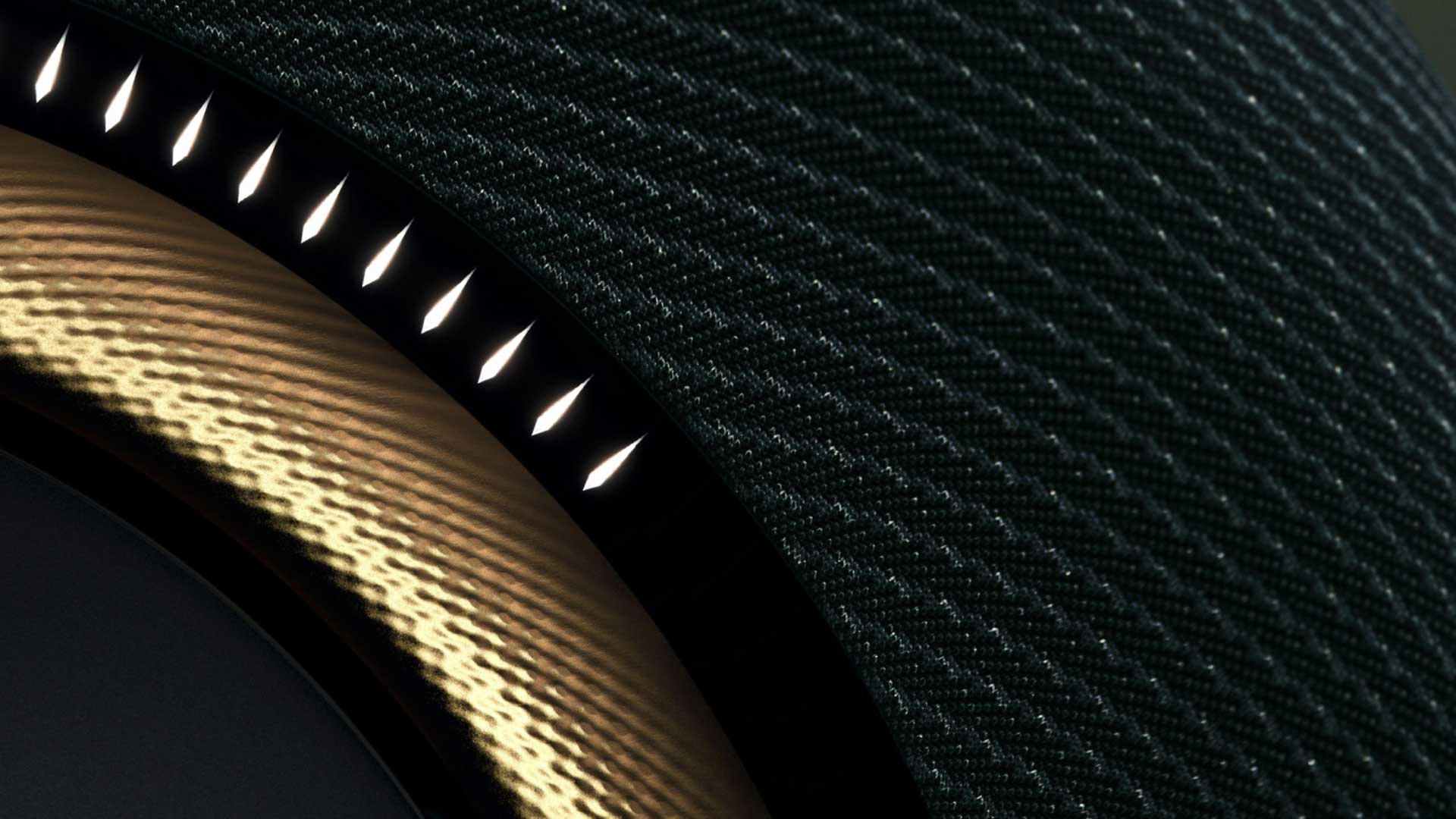
Drivers & power

Drivers: 1 x 165mm woofer, 3 × 50mm ‘wideband’, 2 × 25mm tweeters
Power: 310W (FTC rating, 1% THD, 20-20kHz)
Inputs: RCA analogue, optical digital, USB-C, HDMI eARC, Ethernet/Wi-Fi, Spotify Connect, Tidal Connect, Qobuz Connect, Bluetooth (SBC only), HEOS streaming/multiroom
Dimensions (hwd): 364 × 210 × 387.5mm
Weight: 12.5kg
Nearly all our words so far have been focused on the Horizon’s looks, with not so many yet about the technologies.
And to be fair, that’s in keeping with Marantz’s current incarnation under Masimo Consumer, where it has been redefined as a luxury brand, thereby differentiating itself from sister products by Denon, which has now been defined as a ‘performance’ brand. In a recent Marantz presentation, company representatives repeated a mantra that now “Marantz is about putting beautiful objects into people’s homes.”
This is very different to the traditional Marantz brand epithet “Sound Matters”, but it is to be assumed that the modern mantra of beauty extends to both looks and sound. Circles and spheres are certainly excellent shapes in acoustic terms (there would be many more spherical speakers in the world if they weren’t so dastardly expensive to build compared with a six-walled box) and Marantz even attempts to claim that this circularity is a deliberate reimagining of the classic Marantz amplifier ‘porthole’ display “as the core element of each speaker’s unique circular form”.
Yeh sure, if you like – though the Horizon only partially leverages the true power of the circle: this is not like a Cabasse sphere with multiple drivers positioned concentrically within each other. Instead that dark fabric around the outer circle conceals five drivers (see below): three 5cm (2-inch) mid-cones bravely described as ‘wideband’, and a pair of one-inch tweeters for high frequencies.
Then in the centre is the large 16.5cm (6.5-inch) bass driver behind that frontplate, and since almost nothing in the Horizon gets away without a buzzword or neologism, this has been called a Marantz ‘Gravity’ driver, despite being vertical, and thereby fighting gravity rather than utilising it in any useful way.
The larger Grand Horizon has room for more and bigger drivers: it boasts an eight-inch central ‘Gravity’ driver, four 3-inch midrangers, and three tweeters.
We should also compliment the thick braided mains cable here for its quality, providing a long-life and safe pipe to provide power to the Horizon’s amplifiers.
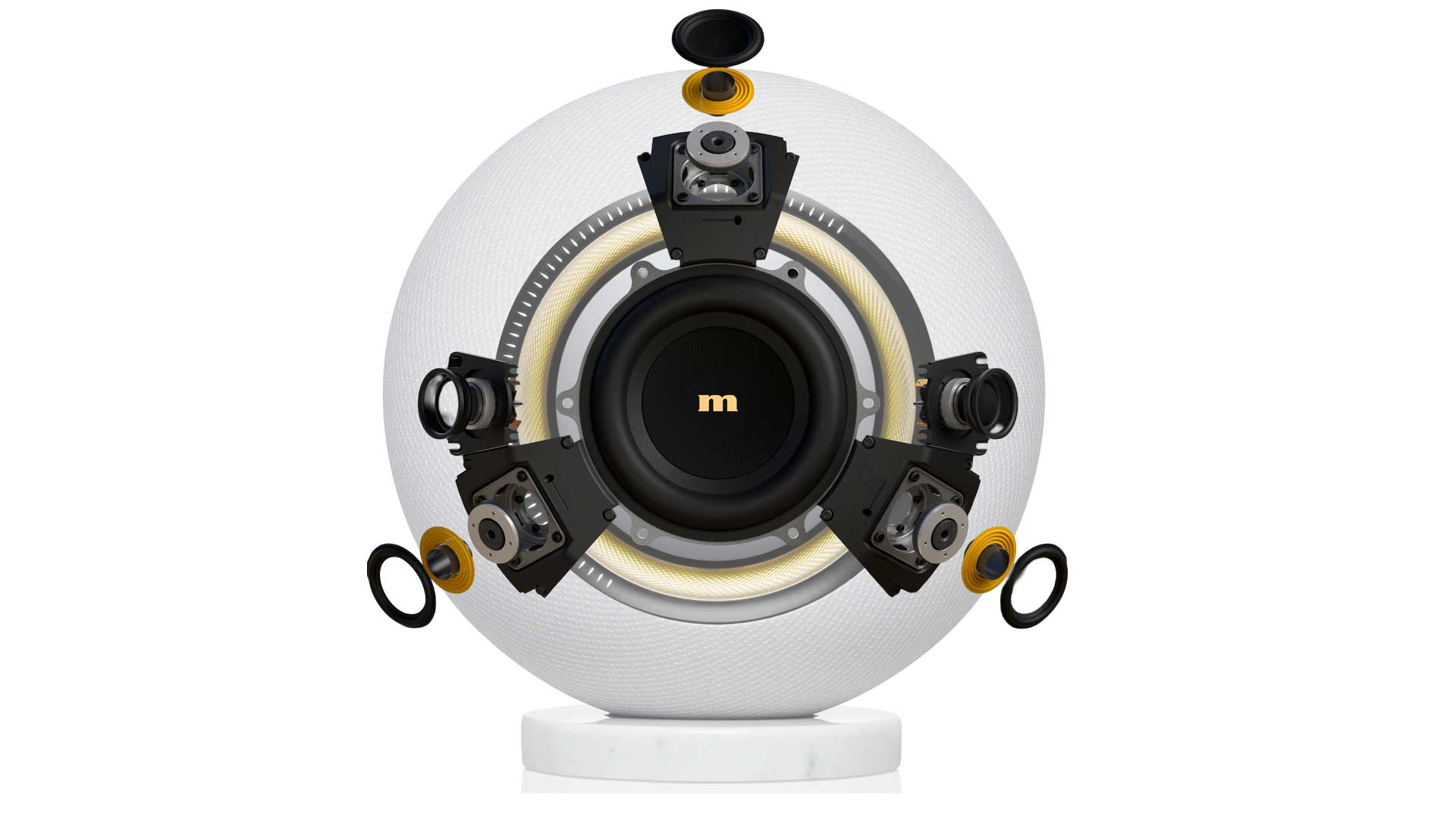
Gallium-nitride power
One further buzzname goes to the amplification inside the Horizon, which is called ‘Rise’, a title which may be derived from the fast rise time of the gallium-nitride FETs (field effect transistors) used therein.
If you haven’t yet encountered GaN, you can expect to hear more of it in our hi-fi futures, as it provides an alternative to silicon in transistors. Gallium-nitride allows Class-D amplifiers to do their PWM switching at far higher frequencies (typically 800kHz for GaN, about double that possible with silicon Class-D); among advantages from this is that a simpler filter can be used, almost eliminating phase shifts in the audible band and up to 30kHz. Early examples of GaN designs have had their sound compared with low-wattage Class-A or even single-ended valve amplifiers.
One potential brake on GaN development may be that gallium mining is dominated by China and Russia – but happily we have some of the stuff here in Australia, too, with several local companies already feeding the GaN transistor market.
We note, however, that Marantz hasn’t leapt to GaN for its high-end amplifiers, and in a recent online briefing the team indicated that it considers the Purifi ‘Eigentakt’ circuits used in its recent Model 10 amplifier to be well superior to the Horizon’s power circuits.
But what if Purifi itself were to implement GaN?, we wondered. So in a slight digression from our review, we contacted our friends at Purifi in Denmark to ask them about that. Purifi’s Claus Neesgaard responded.
“While GaN FETs offer faster switching speeds – approximately twice as fast as traditional silicon devices at 150V – their impact on distortion reduction in typical home audio class D amplifiers is incremental, given the extensive refinements we already achieved in our Eigentakt designs”, replied Claus. “We believe that GaN’s true advantage lies in high-voltage, high-power applications (above 200V), where silicon FETs struggle, making GaN the practical choice for demanding scenarios such as 1kW+ amplifiers. Consequently, our approach is to adopt GaN technology judiciously, leveraging its strengths in areas where it truly enhances performance rather than relying on it as a mere buzzword. In any case, some truly exciting Purifi developments lie ahead.”
So now you know. Anyhoo, GaN debate aside, the resultant output power for the Marantz Horizon is a generous 310W, this quoted under specifications governed by the FTC (which is the US Federal Trade Commission, assuming it hasn’t been fired yet) which measure continuous power across the full 20-20kHz band allowing a figure of 1% THD. This figure of 310W is far higher than an equivalent hi-fi rating (measured with, say, a lower 0.01% limit on THD) would yield, but it is lower than European AV ratings, which can take place at 10% THD on items like soundbars.
It’s nigh impossible to compare between such numbers sensibly, so the only true comparison is with the Grand Horizon, whose power under the same regimen hits 370W. Other comparison points between the two include the quoted maximum SPL of 104dB continuous and 114.5dB peak for the Horizon, compared with a significantly higher 111dB/122dB for the Grand Horizon (remembering that 3dB is a doubling of effective acoustic or electrical power), and also the low frequency response, quoted to 30Hz at -3dB and 22Hz -10dB for the Horizon, but with a few extra notches from the Grand to drop to 28Hz at -3dB, and 18Hz at -10dB.
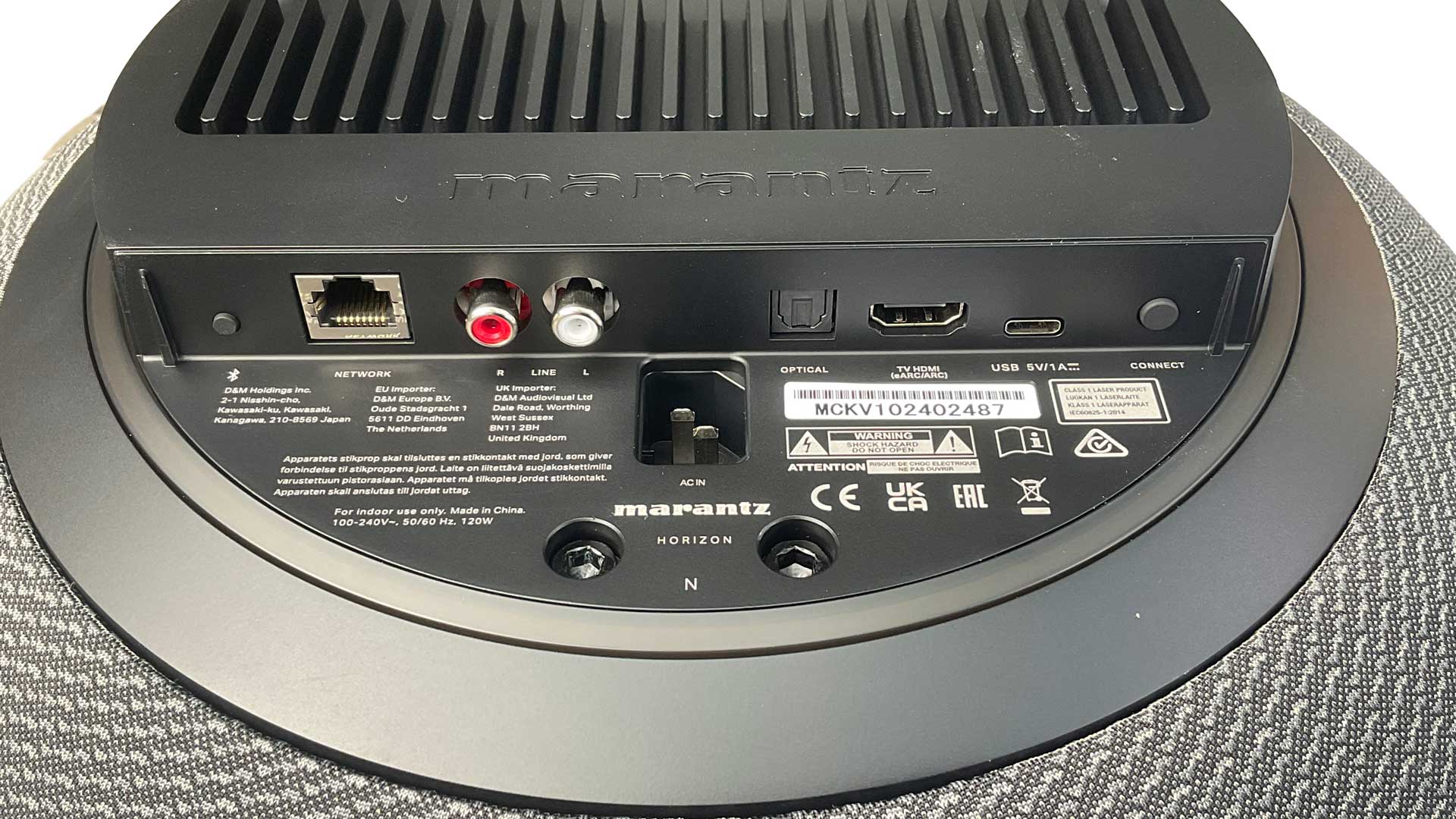
Inputs are available...
It is probable that many users will never connect a source to their Horizon, since streaming is the thing these days, and the Horizon is fully equipped with the Denon/Marantz HEOS streaming and multiroom platform, wrapping any number of streaming and networked options within its easy-to-use app: TuneIn internet radio, iHeartRadio, Amazon Music, Soundcloud, Deezer and more. There is both Spotify Connect and Tidal Connect native playback (Qobuz Connect was added after we had sent it back), so you don’t even need the HEOS app for those: just use the Spotify/Tidal apps as you normally would and select the waiting Horizon as the ‘speaker’.
You can also access network shares of files via HEOS and play them up to 24-bit/192kHz PCM and double-DSD (5.6MHz). Rather interestingly the specs say it can also play multi-channel PCM up to 7.1 channels – and indeed it can; this proved the first streaming unit we’ve ever had successfully stream a multichannel test file of Wish You Were Here with all its bits intact!
It even has Atmos decoding (primarily from its HDMI input (see below), though how it spreads these potential additional channels around its drivers is hard to guess; it seemed to treat the multichannel Floyd evenly and purely, with no attempt at fakery to throw stuff around.
There is also both Bluetooth here, and AirPlay 2 available. While the Bluetooth profile is a thoroughly up-to-date version 5.4, the actual music transmission is limited to the lowest-level SBC codec; AirPlay 2 streaming of Apple Music will also be limited (by Apple, presumably for robustness) to 256k AAC streaming. So we’d suggest you use these only for temporary convenience playback, because it’s easy to get tunes over from your device at much better quality.
Instead open up the HEOS app and find ‘My Device’ or the equivalent, and play tracks that way, because this path should use UPnP at full file quality.
You can, incidentally, use either the Horizon’s Wi-Fi for networking or attach an Ethernet cable to the rear, alongside the inputs, all of which are cable-managed behind a nice magnetic backplate. The rest of the inputs offer an analogue RCA pair, a USB-C socket for file storage devices (FAT32 NTFS-formatted sticks or drives), an optical input, and finally that HDMI-ARC socket.
So while either of the last two sockets could be used to play back audio from your TV, doing so via optical would be pretty frustrating, as you’ll have no remote control to adjust volume. Using the HDMI-ARC socket, however, you’ll have both the possibility of Atmos decoding and, if all works properly, easy control via your TV remote.
The idea of using the Horizon for TV sound prompts the obvious question of where you might put it – it’s too big to go with a benched TV, so would really suit only TVs that are wall-mounted quite high, where the Horizon could go in the middle underneath. You might buy two Horizons and use the HEOS app to create a stereo pair either side of your TV – but the manual does warn of possible sync delays when combining HEOS speakers, so perhaps not.
Unboxing & AuraControl
So as mentioned, Marantz has done a fine job on the perceived value front. There’s the initial proxy reassurance of weight. The unboxing itself is next-level, the container having TV-box-like release clips around the base so you simply raise the carton upward in a grand reveal (or a standard reveal, in our case), unveiling the Horizon there inside in a soft case with a handle that allows you to safely lift it out and position it where you will, without getting your fingers all over it.
Although you are soon encouraged to do so (put your fingers over it, that is), or at least around the control strip that surrounds the illuminated ring. This is called (incoming buzzword) Marantz AuraControl, and includes “unique” on-board proximity sensors which “magically” bring the speaker to life, activating 100 “carefully-concealed” (and yet remarkably visible) LEDs with ambient light sensors. You then touch the illuminated ring around the central subwoofer to indicate your preferred volume.
The sensor detects your approach and illuminates the control ring. Or at least it does so reasonably quickly if the ‘status light’ ring is already illuminated. Once it slips into its unilluminated standby mode, it is rather slower to react. We could walk up to it and wave our hands in front of it for two to three seconds before it would wake up.
In the settings you can change a ‘power saving’ setting to ‘quick start’ to avoid standby (“device will respond immediately… however it will consume more energy”) which then leaves the Horizon always more ready to detect, taking perhaps a second to react.
We found using that control strip rather disappointingly non-intuitive. We can pretty much guarantee that anyone meeting the Horizon for the first time will try to control it as follows: once the circle of LEDs illuminates, they will put their finger where indicated and drag the volume control to where they want it. It’s the natural thing to do. So why Marantz’s much-vaunted design team didn’t make it work in this obvious way is something of a mystery. You can’t drag the volume indicator – as you would a volume slider on, say, your phone, or indeed on any other volume slider we’ve ever yet come across. Instead Marantz wants you to ignore where the volume currently is, and just poke the control ring at the place you want it to go.
Got that? Poke, don’t drag.
There’s also an entirely invisible button below for Play/Pause (single tap), Skip Forward (double tap), and Skip Backward (triple). Making this control button entirely invisible at the bottom of the control ring is similarly dim thinking from the design team; we only found it quite late in the review when reading through the full manual.
Marantz’s local team made the fair point that this is all a ‘WYKYK’ thing (when you know, you know), but at the beginning you don’t know, so that the hidden buttons, the waiting thing and the poke-don’t-drag thing combine to let down the AuraControl system. The purpose of design is not just to make something beautiful, but also to make it functional and intuitive; it’s a disappointment when things don’t work as you might expect.
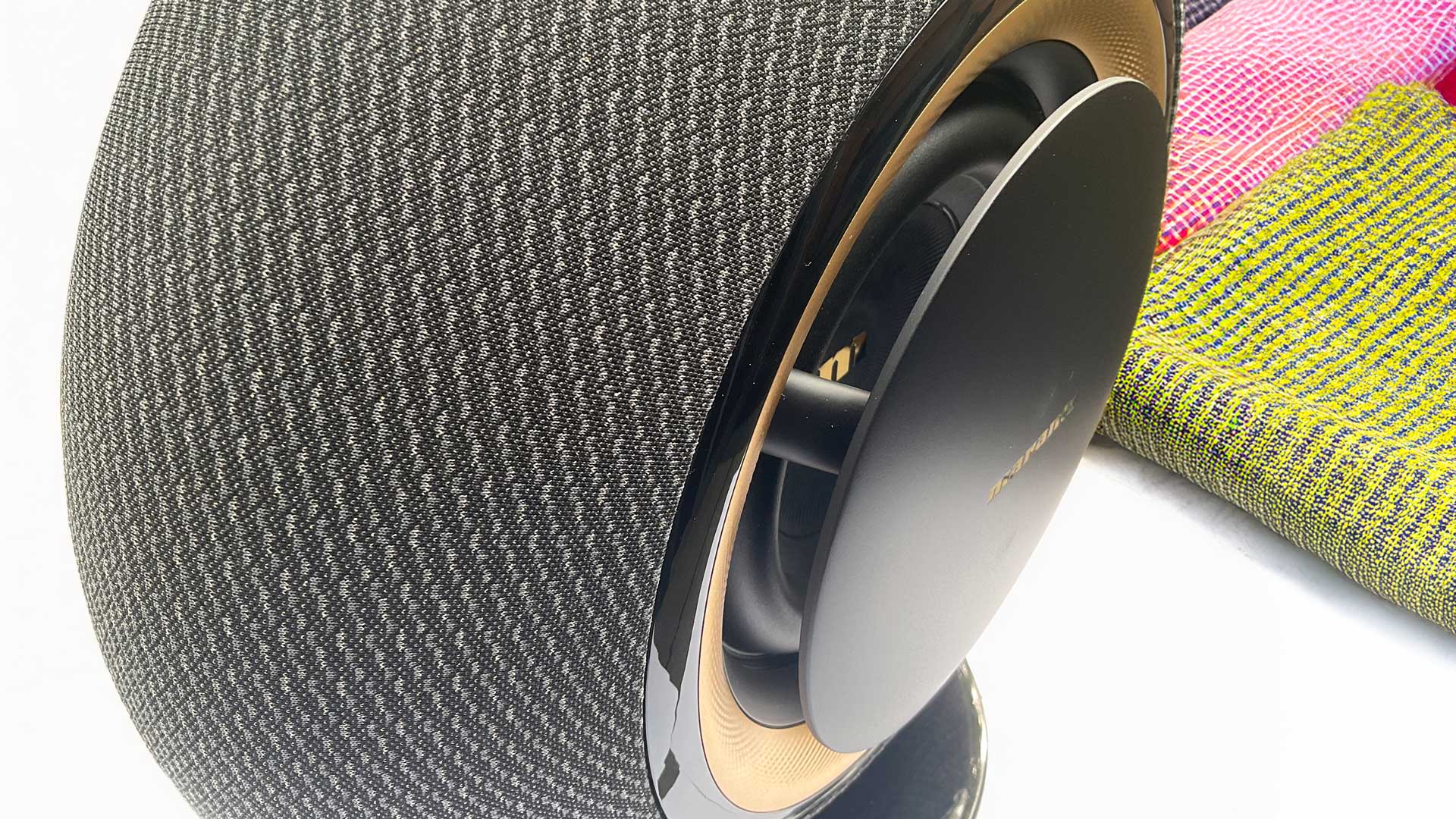
Listening sessions
When you’re streaming, however, you can initially use your phone to control the volume. This is the easy way to use the Horizon: just open the Spotify, Tidal or Qobuz app, assign the output to the Horizon, and you’re off.
The Horizon immediately revealed an ability to roll out some impressively phat bass as Tidal played Nardo Wick’s I Wonder; it’s rather unpleasant rap, distinguished only by big synth bass notes which go mighty low, and which the Marantz nevertheless rolled out with some impact, while keeping everything above clean and tight: a good start.
Acoustic instruments can sound fantastic: the saxophone lead through Eden Ahbez’s arrangement of Nature Boy (which he wrote) sounded full and nuanced; a recent solo cello piece sounded perfectly rosinous and scratchy, with even its small church acoustic evident through the Horizon’s tweeter complement.
We backed up in time to Aretha Franklin’s Respect; the Horizon gave this recording an edge and an almost surprising spaciousness, with a deep cut-through to Aretha’s vocal and the horns, while Donald Dunn’s bass felt full and funky right down its range.
Compare this with Marlena Shaw’s Davy (1974, Blue Note), which starts with her vocal and piano, well worth turning up through the Horizon, though only until verse three, when the band joins in and the level rises: behind this more complex arrangement the vocal began sounding recessed and processed, with only the drums and right-channel guitar really cutting through the slightly mushy whole, as if the complexity was preventing some elements being fully rendered.
We endeavoured to fix this with placement. We had already toyed with the ‘placement EQ’ options (under Settings in HEOS), which offer a choice of free space, single wall/shelf, or corner positioning: the latter settings drop the bass slightly to counter the wall reinforcement. We found the best response across material came from the free space setting, with the Horizon given at least a metre of space all round. If you can give the Horizon these conditions, it greatly clarifies the performance by prioritising its direct sound, and not pushing it to its volume extremes.
Alex The Astronaut’s earlier material can sound soft on some systems, but not here with the free space setting employed. The disturbing words of I Like To Dance were all too clear, no hint of sibilance, the simple backing perfectly posed and supportive, the emotion fully served by a front-and-forward vocal. It also managed a fairly powerful delivery of The Flaming Lips’ All We Have Is Now, this time without surrendering to its considerable complexity; it sounded suitably giant and unconstrained.
Good so far, then, but with some artefacts. At one point we were playing a classic 10CC track from an old network share (to test the ‘Server’ function in HEOS), and though the track sounded full and fairly pop-tastic, the balance was just a little edgy.
We looked for redress. We had been all through the HEOS settings, but noticed now a separate EQ button that appears only when you’re in the fullscreen ‘Now Playing’ mode. This accesses a ‘Sound Mode’ selector.
We had been, by accident rather than default, it seems, in ‘Sound Master’ mode, an EQ setting presumably tuned by Marantz’s current Sound Master. From this showing, he/she seems to like his/her sound slightly pumped, boxed and brightened, as changing the Sound Mode back to ‘Auto’ softened the excess on the 10CC track nicely, and went on to transform everything that followed.
So we went back to Marlena Shaw: the bass rolled out more deeply now, and the vocal – heavens, tranformed from boxy to pure, no longer lost, no longer confusion.
With ‘Auto’ EQ, Aretha suddenly sounded like Atlantic soul instead of something slightly processed. A strange thinness to Elton’s piano on Tower of Babel changed to a completely natural tone; his vocal was similarly purified. Pearl Jam’s Last Exit now positively thundered from the Horizon with masses of space in which to fly. In a word: transformative.
So that ‘Sound Master’ EQ seems to be like a ‘showroom mode’ on a TV: superficially impressive, perhaps, but don’t use it at home! Thankfully Marantz confirms that Horizons ship with the ‘Auto’ setting as the default EQ, not ‘Sound Master’.
You can also build your own EQ using a setting called ‘MyMirage’ – MirageDSP being the buzzname for the EQ in the Horizon, itself with three entertainingly-named adjustments: ‘Warmth’, ‘Spaciousness’ and ‘Clarity’, which we’re sure are entirely unrelated to bass, mid and treble, and probably took several meetings (it would have been lunches in the old days) to decide upon. We played with these, but in the end we just stuck with ‘Auto’; it’s great.
So with all this sorted, we were thoroughly enjoying the Horizon. Don’t get us wrong – there’s plenty that a proper hi-fi system would deliver over and above the Horizon’s circle-bound drivers. Stereo imaging is minimal from any distance, depth of soundstaging likewise; the performers are not truly summoned to life in your room in the way a good hi-fi system might achieve. But for the upper wireless speaker market where this unit sits, we doubt that anyone swayed by the Horizon’s visual charms will be less than satisfied by its aural ones.
It’s notably good with spoken voices as well, and we listened with great pleasure to many hours of podcasts and Audible books through the Horizon. Radio too – there’s no FM or DAB, but the HEOS app includes TuneIn internet radio for a world of varying bit-rate stations to which the Horizon is well suited for playback.
HEOS also allows easy multiroom operation and ‘whole-house playback’ with other HEOS units, should you have any, or plan to get them later – HEOS options run from small wireless speakers to class-leading multichannel AV receivers, so there are plenty of options for expansion.
We did plug it in via HDMI, and used it below a projection screen where there was room to fit its rising bulk. It did a great job with TV and movie dialogue (again, stick with ‘Auto’ sound mode; the ‘Sound Master’ setting slightly phases up dialogue), and stood ready to punch out some excellent music concerts. Don’t miss the magnificent 1975 Springsteen London gig on SBSOnDemand (in Australia) if you haven’t seen it: a two-hour recording of the E-Street Band just on fire at the Hammersmith Odeon, which the Horizon rolled out entirely enjoyably at a fair old level (one occasion of several when we found we were playing up at the Horizon’s maximum). There was full hair-raising and eye-welling at the entry of Born To Run, so it must be doing something right.
A few small operational glitches, almost inevitable on a product of this functionality: Tidal Connect worked from our laptop but not always from our iPhone (the Horizon was visible there, but unresponsive); the Horizon didn’t behave when playing via AirPlay from an AppleTV 4K media player, resisting volume control other than by manual poking, and dropping its AirPlay link after only a relatively short pause of playback. But this was an early (though full production) Horizon unit, and firmware updates will no doubt iron out some early creases like this.
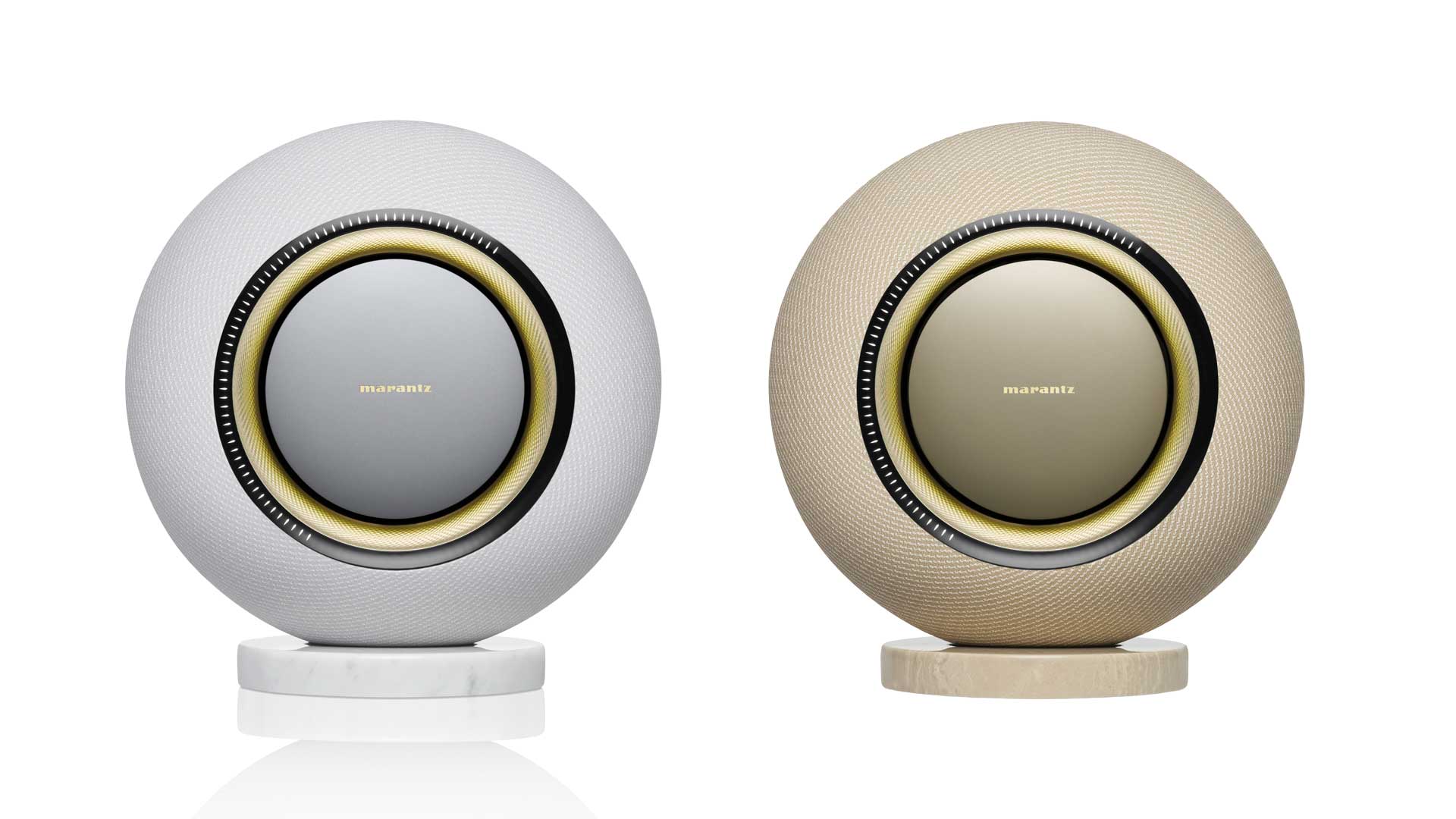
Verdict
There are plenty of ‘wow’ moments with the Marantz Horizon – the weight, the marble, the ring of gold, and of course the cough-inducing price.
Those wedded to the merits of a traditional hi-fi system should not trade that idea for the Horizon: its sound is good, strong, powerful, even pure when in its ‘Auto’ EQ mode, suitable for medium-sized rooms. But of course it has the characteristics of a single-unit system: its sound lacks the width and soundstaging of real hi-fi.
Yet it is well-cast for its chosen role: the Horizon really does look the part. Its control system is seamless via a smart device running HEOS, Spotify or Tidal, and while we found the AuraControl ring to be non-intuitive upon first meeting, it’s fun enough once you’ve learned how it works.
We must assume that anyone shopping for a wireless speaker at this price has sufficient money to expend on Marantz’s now “luxury” line of “beautiful objects”, and we can reassure these well-heeled consumers that the Horizon also comes with a strong dose of the company’s formerly inherent focus on sound quality.

Jez is the Editor of Sound+Image magazine, having inhabited that role since 2006, more or less a lustrum after departing his UK homeland to adopt an additional nationality under the more favourable climes and skies of Australia. Prior to his desertion he was Editor of the UK's Stuff magazine, and before that Editor of What Hi-Fi? magazine, and before that of the erstwhile Audiophile magazine and of Electronics Today International. He makes music as well as enjoying it, is alarmingly wedded to the notion that Led Zeppelin remains the highest point of rock'n'roll yet attained, though remains willing to assess modern pretenders. He lives in a modest shack on Sydney's Northern Beaches with his Canadian wife Deanna, a rescue greyhound called Jewels, and an assortment of changing wildlife under care. If you're seeking his articles by clicking this profile, you'll see far more of them by switching to the Australian version of WHF.
You must confirm your public display name before commenting
Please logout and then login again, you will then be prompted to enter your display name.
